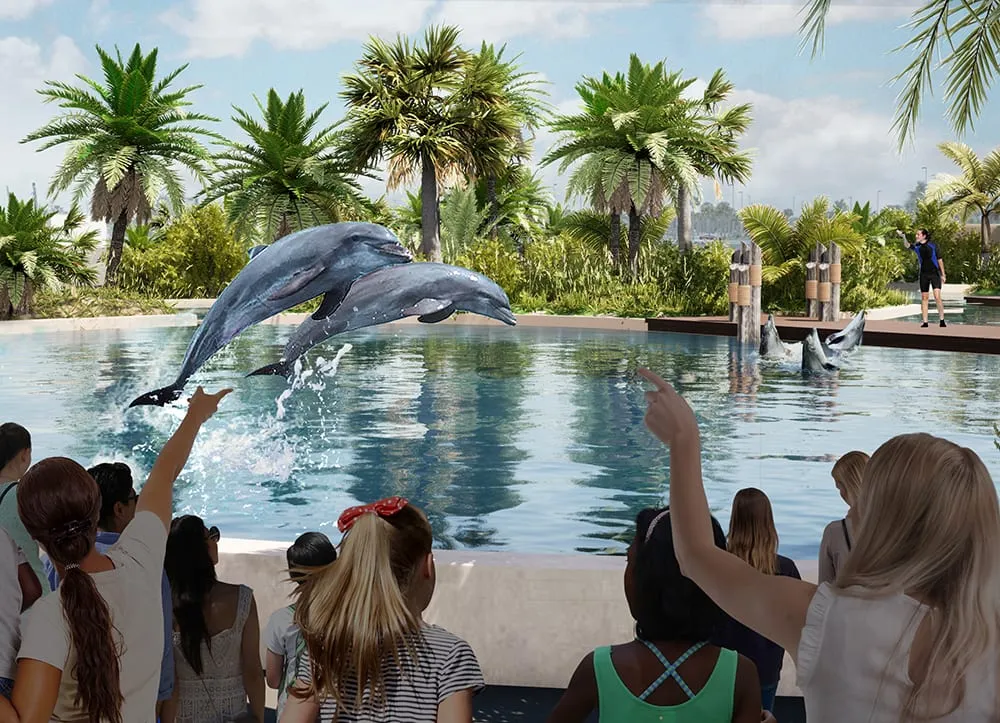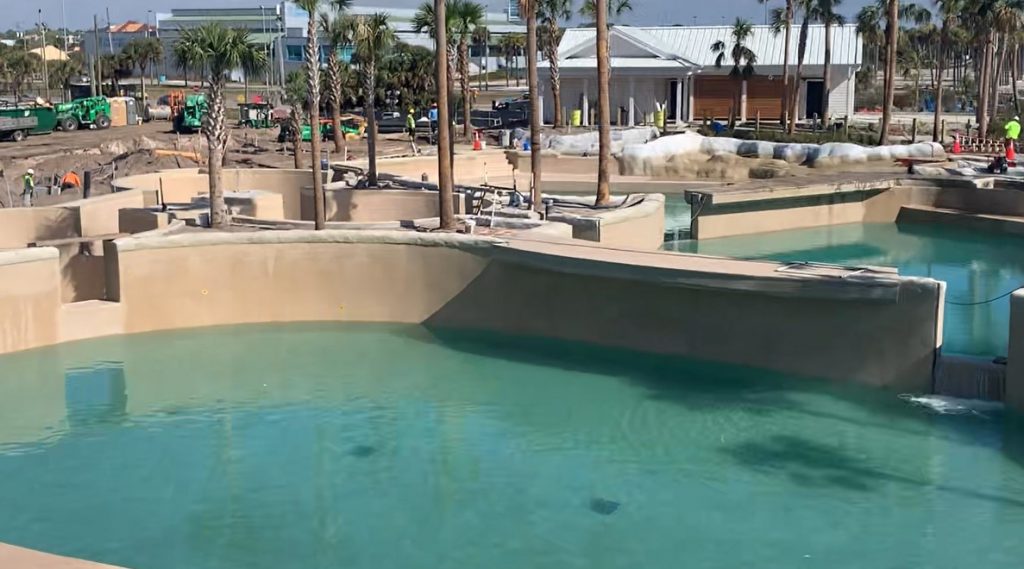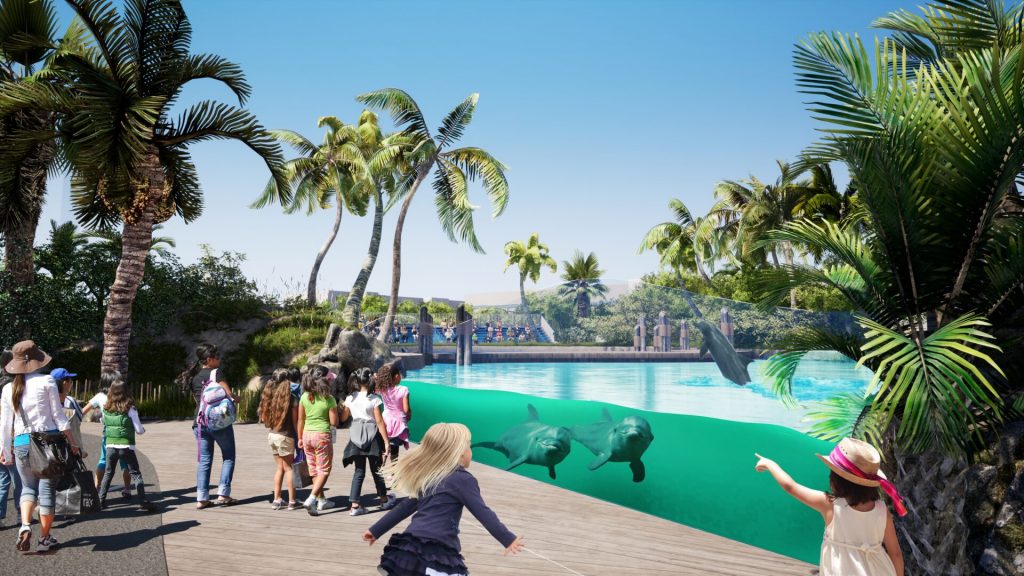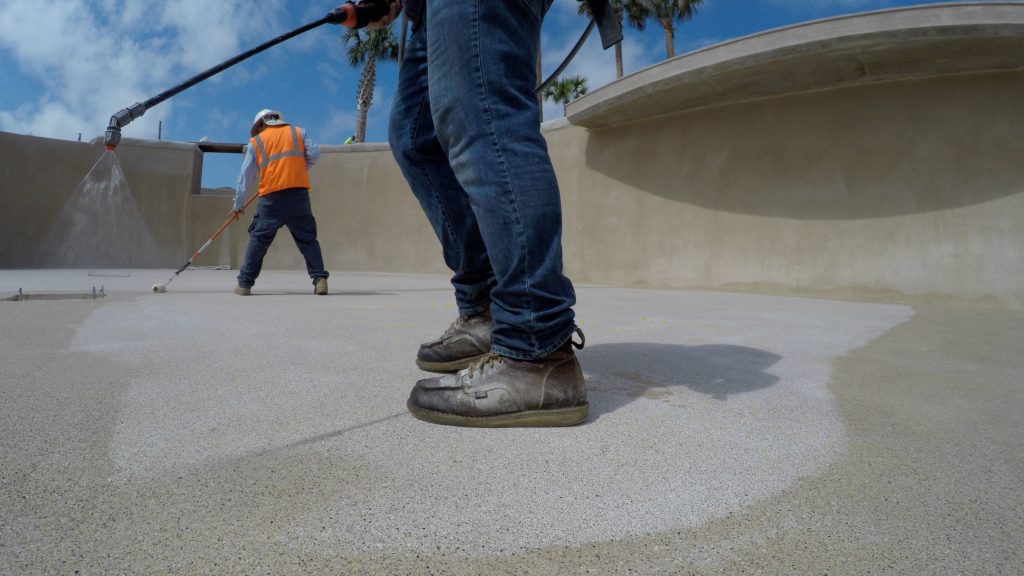Durable for Dolphins


When it came time to install the interior surface at a Florida dolphin facility, Cameron Rhodes turned to a relatively new spray-on treatment designed to enhance plaster durability – a move that prevented damage from a desperate and highly unusual measure during the filling process.
By Cameron Rhodes
After many years in the making, and two full years of design engineering, Gulfarium Marine Adventure Park in Fort Walton, FL, recently completed construction of Dolphin Oasis: a state-of-the-art habitat for housing, treating, breeding, training and displaying dolphins.
I’ve personally been involved with Gulfarium on various projects for almost a decade, either refinishing tanks or looking at re-plumbing various systems. With that experience, I know a few things about the wear and tear vessels that house marine life can experience.
(That said, I know almost nothing about dolphins other than like many other people, I do find them extremely entertaining.)
When the plans were finally released, and the project was announced back in 2020, we were in a good position to join the project team. Our scope of work was simply to install the interior surface. While that sounds simple enough, it was far from a normal pool-plaster job.
A NEW OASIS
The new facility is impressive. It’s designed for animal welfare, guest experience, and conservation-education as the primary objectives. It includes three large, interconnected habitats, totaling over one million gallons.
Each of the three main habitats differs in size and depth, all mimicking environs dolphins occupy in the wild. It also has three “husbandry habitats”, basically medical facilities connected to the main areas.
The new presentation habitat features theater seating for 480 visitors, providing an intimate, up-close show experience.
The exhibit habitat, which will serve as a nursery for the birth of new calves, also features split-level viewing through a 27-foot acrylic window where guests are able to observe the dolphins from above and below the water’s surface.
And, there’s an encounter habitat, where visitors of all ages can play and learn through interactive, hands-on experiences with the ever-so patient resident dolphins.
It’s an amazing place for anyone who admires beautiful sea creatures; and, it’s also a business that needs the work of watershaping professionals to keep it all in good working order.
IN A RUSH
The way that this facility’s set up — with everything interconnected — had huge implications for how it had to be built, especially where the interior surface installation was concerned.
Because the tanks are all interconnected, the whole thing basically had to be treated like one massive vessel. For us, that meant we had to install the exposed aggregate finish as fast as we could; because it was all going to be filled at the same time, and not section by section. We didn’t want the plaster sitting there exposed without water for too long, so the process had to be radically accelerated.
That was one challenge, but then we also had to secure a water supply to fill it as fast as possible, for exactly the same reason. You cannot allow a freshly plastered surface to dry in the sunlight. If you do, the entire surface might become so compromised it might need immediate replacing, or at the very least, would not perform well over time.
I was a firefighter in a former life, and leaning on an old friend, was able to access some 10-inch hose and a fire hydrant wrench. Without seeking any kind of official approval or permission, we hooked up to fire hydrant in the front of the facility, and started filling. Unfortunately, we ran into some serious trouble when unbeknownst to us at first, we drew down a half-million-gallon water tower tank. Evidently, we drank it dry – but had only filled the dolphin vessels about halfway.

That was when the water supply was cut off. We knew we had to figure out a way to fill the tanks the rest of the way, and quickly. In the desperation of the moment, we made a drastic decision. The site was being dewatered during construction, a process that pushed huge amounts of brackish groundwater out to sea. So, improvising in a big way, we took their massive pumps and basically disconnected their hoses and then turned them around and filled the pools — with the unfiltered ground water.
Although we did manage to fill the pools, it was nonetheless a massively unsettling experience. The hoses were belching black silt into these new plastered pools. It was both an ugly and alarming sight. Although it was far from ideal, we kept telling ourselves it was better than leaving the material exposed and probably ruined.
ONTO THE SURFACE
All the ground water made it look like a true black lagoon. We knew we’d have to drain it back down and fill it back up again because there would be no way to effectively clean the water we had been forced to use.
The surface was from Pebble Technology, a modified version of their sandy beach finish with smaller- than-usual pebbles. Exposed aggregate surfaces are a good fit for this type of application because they are less susceptible to showing wear and tear than traditional plaster, and marine exhibits can be extremely rough on an interior surface. In this situation, with the ground water and the impromptu draining and refilling, we could have been in deep trouble.
Fortunately, we had already added a step that most likely saved the day.
Here I’ll indulge a blatant endorsement. A surface treatment product known as MicroGlass had been specified as part of the surface installation, which we had dutifully applied following the installation. Once applied, the product penetrates deep into the plaster matrix, where it causes a series of chemical reactions that in effect, render the surface less susceptible to fluctuating water conditions.
And, as we found out, the treated surface was, much to our amazement, able to resist the insults we had visited upon it!
Since then, I’ve learned some useful information about MicroGlass and its patented active chemical agent, “micro-organized silicate.” It works through a process called “densification.” Products containing silicate have been primarily used as a concrete hardening and densifying agent for decades, but have only recently been used in the pool industry.
When applied to the surface of concrete, or in this case, exposed-aggregate plaster, it penetrates into the porous matrix of the concrete due to its low molecular size and viscosity.
GOOD CHEMISTRY
Once inside the matrix, the silicate reacts with calcium hydroxide and other compounds in the concrete to form additional calcium silicate hydrate (C-S-H) gel, which fills the concrete’s pores and capillaries, effectively densifying the matrix.
The increased density reduces the concrete’s permeability and as a result, enhances durability because it reduces or eliminates water penetration of the surface. The formation of additional gel also results in improved properties of the concrete, including increased compressive strength, flexural strength, and abrasion resistance. It also reduces the surface’s susceptibility to dusting and erosion.
MicroGlass transforms soluble calcium hydroxide into chemically inert calcium silicate hydrate. On the Absolute Hardness Scale, the manufacturer says it goes from a 3 to 75, creating an almost glasslike infusion within the concrete. This is significant because harder particles in the microstructure make the finish more chemically resistant.
Another unique characteristic of MicroGlass is the product’s ability to deeply penetrate. The penetration of traditional densifiers used on cement products is typically a few millimeters (1mm = 1/25th inch). This shallow penetration may slightly protect a surface but will not protect the vulnerable internal microstructure. MicroGlass, as confirmed by independent third party lab data, is extremely unique because it permeates throughout the entire depth (generally 3/8in – 1/2in.), protecting the finish from internal chemical breakdown and calcium leeching.
As it turns out, our situation put the product to quite the test. Fortunately for us, the increased density and reduced permeability worked as advertised. In the bigger picture, treatment enhances the resistance to chemical attack, making the interior surface suitable for use in environments, such as pools and spas, where exposure to chemicals is inevitable.
It also reduces shrinkage, minimizes crack formation, and improves the surface’s long-term performance. MicroGlass can be used as a standalone treatment or in combination with other concrete strengthening and sealing methods depending on what you’re trying to achieve.
BACK IN FLORIDA
It is an added step. MicroGlass is applied with a sprayer, preferably a backpack sprayer with a battery so you’re not manually pumping it. It’s a two-person operation — one doing the spraying, while the other follows with a roller to make sure that it’s spreading properly.
In this case, because the vessel was 12-feet deep in places, we had a guy on top of some movable scaffolding and two guys pushing it, which was a little unusual, but it got the job done.
The results were nothing short of amazing. The surface resisted hydration cracking we probably should have had. We’ve had no efflorescence, spidering, scale or etching. Filling it with treated saltwater, we might expect various corrosive effects, but so far, the surfaces’ performance has been close to perfect.
As for the Dolphins, they couldn’t care less about the nuances of the interior surface treatment, but the facility managers are thrilled.
Cameron Rhodes is principal at Premier Pools & Spas in Fairhope, AL. He is a 20-plus year industry veteran, managing sales, administration, construction and subcommittee contractors.











